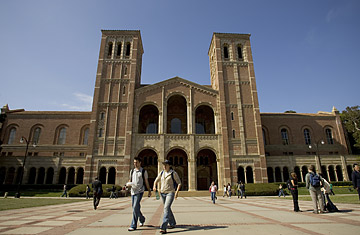
Royce Hall at the University of California, Los Angeles
On its face, it would seem to be a gift to Barack Obama's conservative critics, who have spent the summer painting the new Democratic President as a socialist who is eager to nationalize the entire health-care system. After all, the Administration's proposal to restructure the student-loan industry is, in many respects, much closer to an actual government takeover than its relatively tame market-driven health-reform plan. But as the House holds hearings and looks likely to pass a student-loan bill this week, it's clear that the education overhaul is not going to be the high-pitched battle that opponents and the White House once expected it to be.
It was only last spring when Obama made clear that he was expecting a fight over the biggest change in the federal student-loan program since its 1965 creation. "The banks and the lenders who have reaped a windfall ... have mobilized an army of lobbyists to try to keep things the way they are," he said in April. "They are gearing up for battle. So am I."
Obama's rhetoric was understandable. His plan is to do away with a system in which the Federal Government subsidizes banks and other private finance companies like Sallie Mae to lend money to students. The Administration essentially wants to cut such companies out of the game and run the system itself. Democrats claim the move will save $87 billion over 10 years, which can be used for a laundry list of education priorities, including increasing the maximum amount of Pell Grants, expanding Perkins Loans and investing in community colleges and other programs.
Many Republicans, not surprisingly, don't see it that way. "This bill is a massive expansion of the Federal Government, pure and simple," says Alexa Marrero, spokeswoman for Congressman John Kline, the ranking Republican member of the House Education and Labor Committee.
Educational institutions currently have two ways to offer federal loans to students. In the Federal Family Education Loan (FFEL, pronounced "fell") program, the government pays subsidies to banks and lenders to dole out money to borrowers and reimburses companies up to 97% of the cost of any loan that is not paid back. The second way is the direct-loan program, created in 1993 as an alternate option, in which the government cuts out the middle man, lends money directly and gets all the profits. If the Student Aid and Fiscal Responsibility Act (SAFRA) passes both houses of Congress, the approximately 4,500 colleges and universities that are currently signed up for FFEL will have to abandon the program and start using the direct-loan option by July 1, 2010.
The health-care debate would seem to help critics of the student-loan plan, who have no qualms about trying to link the two. "One of the points we're making is that the parallels to the health-care debate are really eerie," says Marrero. "The direct-loan program was created as a public option 16 years ago. It was touted as a form of competition that would encourage innovation and keep the industry honest. Sound familiar?" But rather than fuel significant opposition to the student-loan plan, the health-care firestorm has overshadowed it, making it harder for opponents to rally an effective counterattack.
Still, the bill could have a hard time in the Senate, where the Administration will need to cobble together 60 votes to prevent the threat of a filibuster. And those in the loan industry certainly aren't giving up. "Ultimately, what they are trying to create here is the Post Office of student lending — you've got no choice," says Jack Remondi, vice chairman and CFO of Sallie Mae, the nation's largest lender, referring to Obama's Aug. 11 comments that questioned the efficiency of American letter carriers. "And this is the President's initiative on health care: if you create competition, that should drive down costs and save people money."
The loan industry estimates that up to 35,000 jobs might be lost by the transfer from FFEL to direct-loan. Members of Congress who represent states that employ a large portion of the industry workforce, like moderate Democratic Senator Ben Nelson of Nebraska, have opposed the measure for that reason. But the Department of Education (which would run the new and expanded program) maintains that because Sallie Mae and several other companies would be kept on as contractors to "service" the loans — performing administrative tasks such as answering student inquiries and collecting payments — the total amount of jobs lost will actually be much less. It doesn't hurt the Administration's case that over a year ago, when the credit crunch paralyzed the markets, Congress had to pass a law allowing the Department of Education to buy student loans back from the lenders to ensure that money would continue to flow to students. Approximately three-quarters of the FFEL loans in the 2008-09 academic year were already in the hands of the government.
Separate from the ideological tussle, university officials have their own concerns about the timing of the plan. While Education Department officials claim that most schools can easily make the transition from one system to another, some financial-aid administrators are skeptical about a July 1 switchover. "All of our information for the 2010-2011 academic year is already printed," says R. Dewey Knight, the University of Mississippi's associate director of financial aid. "Colleges have a financial-aid calendar that starts in November for the following year, not in July. I think the Administration really believes you can just throw a switch and everything will change over. But as someone who actually has to throw that switch, I can tell you that there's a bunch more switches behind that one that you don't even see. It's not that simple." Still, for an Administration that fully expected a knock-down, drag-out fight over the student-loan plan, those kinds of problems probably seem pretty easy to solve.
